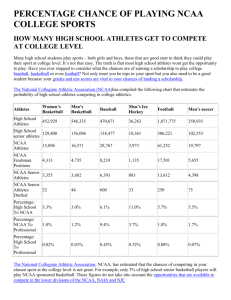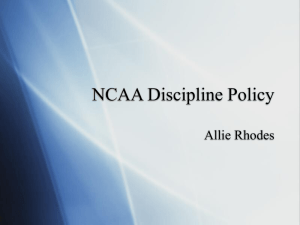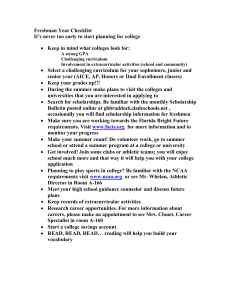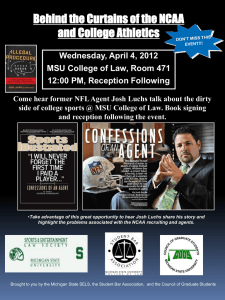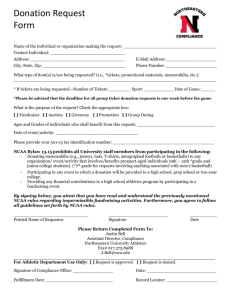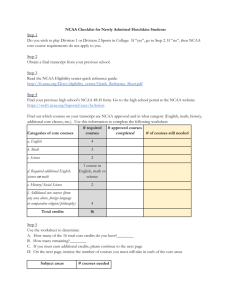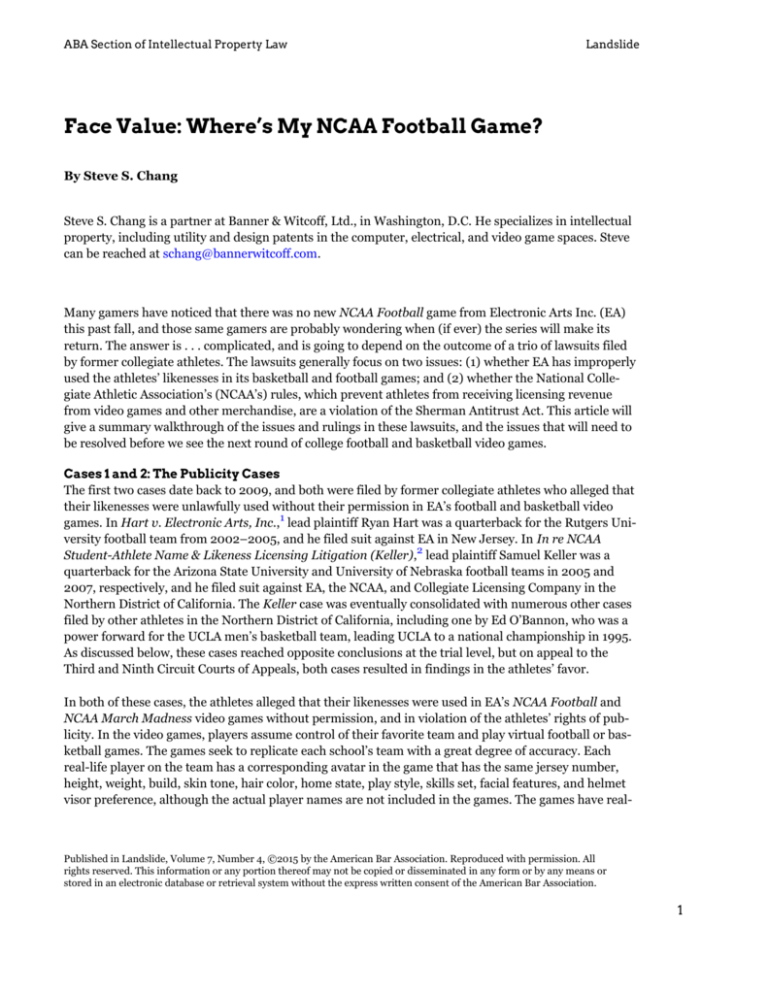
ABA Section of Intellectual Property Law
Landslide
Face Value: Where’s My NCAA Football Game?
By Steve S. Chang
Steve S. Chang is a partner at Banner & Witcoff, Ltd., in Washington, D.C. He specializes in intellectual
property, including utility and design patents in the computer, electrical, and video game spaces. Steve
can be reached at schang@bannerwitcoff.com.
Many gamers have noticed that there was no new NCAA Football game from Electronic Arts Inc. (EA)
this past fall, and those same gamers are probably wondering when (if ever) the series will make its
return. The answer is . . . complicated, and is going to depend on the outcome of a trio of lawsuits filed
by former collegiate athletes. The lawsuits generally focus on two issues: (1) whether EA has improperly
used the athletes’ likenesses in its basketball and football games; and (2) whether the National Collegiate Athletic Association’s (NCAA’s) rules, which prevent athletes from receiving licensing revenue
from video games and other merchandise, are a violation of the Sherman Antitrust Act. This article will
give a summary walkthrough of the issues and rulings in these lawsuits, and the issues that will need to
be resolved before we see the next round of college football and basketball video games.
Cases 1 and 2: The Publicity Cases
The first two cases date back to 2009, and both were filed by former collegiate athletes who alleged that
their likenesses were unlawfully used without their permission in EA’s football and basketball video
games. In Hart v. Electronic Arts, Inc.,1 lead plaintiff Ryan Hart was a quarterback for the Rutgers University football team from 2002–2005, and he filed suit against EA in New Jersey. In In re NCAA
Student-Athlete Name & Likeness Licensing Litigation (Keller),2 lead plaintiff Samuel Keller was a
quarterback for the Arizona State University and University of Nebraska football teams in 2005 and
2007, respectively, and he filed suit against EA, the NCAA, and Collegiate Licensing Company in the
Northern District of California. The Keller case was eventually consolidated with numerous other cases
filed by other athletes in the Northern District of California, including one by Ed O’Bannon, who was a
power forward for the UCLA men’s basketball team, leading UCLA to a national championship in 1995.
As discussed below, these cases reached opposite conclusions at the trial level, but on appeal to the
Third and Ninth Circuit Courts of Appeals, both cases resulted in findings in the athletes’ favor.
In both of these cases, the athletes alleged that their likenesses were used in EA’s NCAA Football and
NCAA March Madness video games without permission, and in violation of the athletes’ rights of publicity. In the video games, players assume control of their favorite team and play virtual football or basketball games. The games seek to replicate each school’s team with a great degree of accuracy. Each
real-life player on the team has a corresponding avatar in the game that has the same jersey number,
height, weight, build, skin tone, hair color, home state, play style, skills set, facial features, and helmet
visor preference, although the actual player names are not included in the games. The games have real-
Published in Landslide, Volume 7, Number 4, ©2015 by the American Bar Association. Reproduced with permission. All
rights reserved. This information or any portion thereof may not be copied or disseminated in any form or by any means or
stored in an electronic database or retrieval system without the express written consent of the American Bar Association.
1
ABA Section of Intellectual Property Law
Landslide
istic virtual versions of the schools’ respective stadiums as well, with coaches, cheerleaders, fans, mascots, and sounds helping to replicate the real-life game experience.4 In both of these cases, EA asserted
that any athlete’s likeness appearing in EA’s video games is protected by the First Amendment.
These cases reached different outcomes at the trial level. In Hart, the district court granted summary
judgment to EA on the grounds that EA’s First Amendment right to free expression outweighed the athletes’ right of publicity.5 In Keller, the district court found that the athletes’ right of publicity claims had
a probability of prevailing over EA’s First Amendment defense, and denied a motion by EA to strike the
claim under a California law that permitted such motions in cases involving the First Amendment. 6
On appeal, both appellate courts (Third and Ninth Circuits, respectively) ruled in the athletes’ favor. In
Hart, the Third Circuit ruled that EA’s use of the plaintiff’s likeness did not escape the plaintiff’s right of
publicity claim, and that the lower court had erred in granting summary judgment to EA. In Keller, the
Ninth Circuit found that EA’s use of the likenesses of college athletes was not protected by the First
Amendment, and affirmed the lower court’s denial of EA’s motion.
The analysis and reasoning that led to these decisions was largely in common, and will be discussed in
detail below.
The Analysis
Both appellate courts began by noting that video games are entitled to the full protections of the First
Amendment,7 citing Brown v. Entertainment Merchants Ass’n.8 In Brown, the Supreme Court
addressed a California law that governed the labeling and sale of violent video games. In striking down
the law, the Supreme Court noted that video games are entitled to First Amendment protection, and
found that the California law did not comport with the First Amendment.
The appellate courts also both acknowledged that the First Amendment right was not absolute, and that
it may need to be balanced against a state-recognized right of publicity.9 The courts cited Zacchini v.
Scripps-Howard Broadcasting Co.10 for this balancing. In Zacchini, a news program had recorded and
broadcast the entire “human cannonball” act of the plaintiff, Hugo Zacchini. 11 The producers of the
news program argued their First Amendment right to disseminate the news, but the Supreme Court
ruled in favor of Zacchini, noting that there must be a line between Zacchini’s right to publicity and the
press’s First Amendment rights, and that “[w]herever the line . . . is to be drawn between media reports
that are protected and those that are not, we are quite sure that the First and Fourteenth Amendments
do not immunize the media when they broadcast a performer’s entire act without his consent.” 12
So Zacchini established that there was a line, and said that a wholesale rebroadcast of a performer’s
entire act was clearly on the “not protected” side of that line, but it was left to subsequent courts to
decide the other contours of that line. The Hart opinion addressed the three main balancing tests that
were developed in the wake of Zacchini: (1) the predominant use test, (2) the Rogers test, and (3) the
transformative use test, and these tests are summarized below.
Published in Landslide, Volume 7, Number 4, ©2015 by the American Bar Association. Reproduced with permission. All
rights reserved. This information or any portion thereof may not be copied or disseminated in any form or by any means or
stored in an electronic database or retrieval system without the express written consent of the American Bar Association.
2
ABA Section of Intellectual Property Law
Landslide
The Predominant Use Test
The predominant use test originated in Doe v. TCI Cablevision,13 which dealt with the Spawn comic
book. Spawn had a villainous character named “Anthony ‘Tony Twist’ Twistelli,” which a hockey player
(named Tony Twist) alleged violated his right to publicity.14 To conduct the balancing between Twist’s
right of publicity and the comic book creator’s First Amendment rights, the Supreme Court of Missouri
adopted a test that was based on the predominant use of the individual’s identity:
If a product is being sold that predominantly exploits the commercial value of an individual’s identity, that product should be held to violate the right of publicity and not be protected by the First
Amendment, even if there is some “expressive” content in it that might qualify as “speech” in other
circumstances. If, on the other hand, the predominant purpose of the product is to make an expressive comment on or about a celebrity, the expressive values could be given greater weight. 15
The Doe court applied the test and ruled in favor of the hockey player, finding that the reference to Tony
Twist had “very little literary value compared to its commercial value.”16 The Third Circuit in Hart,
however, declined to use this test because it felt that the test was too subjective and required judges to
be both jurists and discerning art critics.17
The Rogers Test
The Hart opinion then addressed, and rejected, the Rogers test.18 The Rogers test originated in Rogers
v. Grimaldi,19 a case in which Ginger Rogers sued the makers of a film entitled Ginger and Fred, a film
that was neither about Ginger Rogers nor Fred Astaire. The case was analyzed from a more trademark
point of view (the name “Ginger” in the title was the only link to Ginger Rogers), and the Second Circuit’s analysis held that Oregon would not “permit the right of publicity to bar the use of a celebrity’s
name in a movie title unless the title was wholly unrelated to the movie or was simply a disguised commercial advertisement for the sale of goods or services.”20 In applying the test to the Ginger and Fred
film, the Second Circuit concluded that the title was not wholly unrelated to the movie and was not a
disguised advertisement, so it dismissed the right of publicity claim.
The Third Circuit in Hart declined to apply the Rogers test because it doubted whether the Rogers test
could be applied beyond the title of a work, and it felt that the test did not adequately balance all of the
nuances of the rights of publicity and free speech.21 The Hart opinion noted that the very reason for
Hart’s fame was football, so anyone misappropriating his likeness would necessarily be doing so for a
product that is not “wholly unrelated” to Hart himself. Under the Rogers test, all such uses of Hart’s
identity would be protected by the First Amendment.
After dismissing the Rogers test, the Hart opinion arrived at the test it ultimately used—the transformative use test.
The Transformative Use Test
The third test, and the one ultimately used by both the Hart and Keller opinions, originated with Comedy III Productions, Inc. v. Gary Saderup, Inc.22 In Comedy III, the issue was an artist’s sale of T-shirts
and prints bearing his charcoal rendition of the Three Stooges.
Published in Landslide, Volume 7, Number 4, ©2015 by the American Bar Association. Reproduced with permission. All
rights reserved. This information or any portion thereof may not be copied or disseminated in any form or by any means or
stored in an electronic database or retrieval system without the express written consent of the American Bar Association.
3
ABA Section of Intellectual Property Law
Landslide
In resolving the question of whether the artist’s First Amendment rights prevailed over the Stooges’
rights of publicity, the California Supreme Court borrowed a concept from copyright law, and articulated a test based on whether the celebrity’s likeness was sufficiently transformed as to create the defendant’s own expression:
The balance between the right of publicity and First Amendment interests turns on “whether the
celebrity likeness is one of the ‘raw materials’ from which an original work is synthesized, or
whether the depiction or imitation of the celebrity is the very sum and substance of the work in
question. We ask, in other words, whether the product containing a celebrity’s likeness is so transformed that it has become primarily the defendant’s own expression rather than the celebrity’s likeness. And when we use the word ‘expression,’ we mean expression of something other than the
likeness of the celebrity.”23
In applying this test, the California Supreme Court found that the charcoal drawing violated the
Stooges’ rights of publicity because there was “no significant transformative or creative contribution”
and “the marketability and economic value of [the work] derives primarily from the fame of the celebrities depicted.”24
Later court decisions followed Comedy III, and additional contours of this analysis began to emerge.
While the Comedy III charcoal drawings lacked the requisite transformation, another example, found in
Winter v. DC Comics,25 showed the other end of the transformation spectrum—an example in which
sufficient transformation was found. In Winter, two musicians, Johnny and Edgar Winter, objected to
the “Johnny and Edgar Autumn” characters in the DC Comic Book Jonah Hex.
In discussing the transformative use test, the Supreme Court of California explained that “[a]n artist
depicting a celebrity must contribute something more than a ‘merely trivial’ variation, [but must create]
something recognizably ‘his own,’ in order to qualify for legal protection.”26 The Winter court noted
that the celebrities were not literally depicted in the comic book and were “distorted for purposes of
lampoon, parody, or caricature.”27 The Winter court also noted that “fans who want to purchase pictures of [the Winter brothers] would find the drawing of the Autumn brothers unsatisfactory as a substitute for conventional depictions.”28
As another example of sufficient transformation, the Hart opinion referred to the Sixth Circuit decision
in ETW Corp. v. Jireh Publishing, Inc.,29 in which a collage that included a photograph of the golfer
Tiger Woods, along with photographs of other golfers, was deemed transformative enough partly
because it did not “capitalize solely on a literal depiction of Woods.”30
The Hart opinion addressed two other uses of the transformative use test, both in the context of video
games: one in which there was enough transformation, and one in which there was not. In Kirby v.
Sega of America, Inc.,31 the celebrity was a musician (Kierin Kirby) who claimed that Sega misappropriated her likeness for the character “Ulala,” appearing in the video game Space Channel 5.
Published in Landslide, Volume 7, Number 4, ©2015 by the American Bar Association. Reproduced with permission. All
rights reserved. This information or any portion thereof may not be copied or disseminated in any form or by any means or
stored in an electronic database or retrieval system without the express written consent of the American Bar Association.
4
ABA Section of Intellectual Property Law
Landslide
The California Court of Appeal noted that, although there were similarities in appearance and in the signature phrases spoken by Kirby and the Ulala character, there were also differences in appearance and
movement, and that the Ulala character was not a mere digital recreation of Kirby. 32 Based on these differences, the California Court of Appeal found that the work passed the transformative use test, adding
“new expression” beyond the celebrity, and that Kirby’s likeness was not the “sum and substance” of the
Ulala character.
While Kirby was an example of a video game that passed the transformative use test, the Hart opinion
also addressed an example of a video game that did not pass the test. In No Doubt v. Activision Publishing, Inc.,33 the musical group No Doubt objected to aspects of their appearance in Activision’s Band
Hero game, a karaoke-style game that allowed players to simulate performance in a rock band by playing simulated instruments along with popular songs. The No Doubt court highlighted the fact that the
No Doubt avatars could not be changed and were images of the celebrity musicians. Despite the other
aspects of the game that may be considered transformative, it found that “no matter what else occurs in
the game during the depiction of the No Doubt avatars, the avatars perform rock songs, the same activity by which the band achieved and maintains its fame.”34 The court found that in the game, the No
Doubt avatars always appeared as depictions of the No Doubt members “doing exactly what they do as
celebrities.”35 The court also noted that the game developers used depictions of the No Doubt bandmembers to capitalize on the fan base of the No Doubt musical group. With these factors in mind, the
No Doubt court concluded that there was insufficient transformation, and that the use violated the
group’s right of publicity.
Having established some contours of the transformative use test, the Hart court set about applying the
test to NCAA Football. The court noted that the appearance of the football player matched the avatar,
with hair, skin, helmet visor, and biographical traits, such that it was a digital recreation of the person.36
The court then noted that, like the bandmembers in No Doubt, the football player avatar in NCAA Football always appeared in exactly the same context as the real-life counterpart—as a football player playing football. As for EA’s argument that other aspects of the game, such as the stadiums and sounds,
were creative and transformative, the court disagreed, noting that the No Doubt environments were
even more transformative because some of the songs could be performed in outer space. 37
Because the No Doubt court gave weight to the fact that the game did not allow alterations to the
appearance of the No Doubt bandmembers, the Hart opinion addressed the ability in the NCAA Football games to alter the player avatars. The game allows players to change the avatars, to alter their
appearance, skills, and various other aspects.38 The court dismissed this, however, by noting that those
changes are at the discretion of the user, and that if this option were deemed sufficient, then it would be
easy for future game developers to misappropriate and benefit from a celebrity’s identity and avoid liability by merely offering an option to change it in the game. The Hart court ultimately concluded that
the NCAA Football game seeks to create a realistic depiction of the game of college football, with realis-
Published in Landslide, Volume 7, Number 4, ©2015 by the American Bar Association. Reproduced with permission. All
rights reserved. This information or any portion thereof may not be copied or disseminated in any form or by any means or
stored in an electronic database or retrieval system without the express written consent of the American Bar Association.
5
ABA Section of Intellectual Property Law
Landslide
tic representations of the schools and players, and like the game in No Doubt, seeks to capitalize on the
fan base of the teams and players.39 The court held that the use of the likeness in NCAA Football was
not sufficiently transformative, and not protected by the First Amendment.
The Keller court followed nearly the same path of analysis as Hart. The Keller court addressed the same
Comedy III/Winter/Kirby/No Doubt line of cases, and further addressed another case in which the
Ninth Circuit applied the test.40 In Hilton v. Hallmark Cards,41 the Ninth Circuit doubted that a birthday card depicting Paris Hilton in a manner reminiscent of her appearance in her television show was
transformative enough.
The Keller court then applied the test to NCAA Football and found that the use of Keller’s likeness did
not contain significant transformative elements.42 The court found the current case to be very similar to
the facts in No Doubt—that the celebrity appears in the same context as in real life—and found that
there was not enough transformation. The Keller court also disagreed that the other aspects, such as the
ability to edit a player’s appearance, constituted transformation, by downplaying the importance of this
point in the No Doubt decision. To the court’s eye, the key issue was that in Winter and Kirby, there
were fanciful, creative characters that, although created based on the public figures, were nevertheless
new characters.
Dissents
Notably, neither Hart nor Keller were unanimous opinions. The dissent in Hart pointed out that the
video games included a myriad of additional graphics, videos, sounds, and game scenarios, beyond the
player likeness, and that these additions should be sufficient to transform the player likeness into a different work, satisfying the transformative use test.43 To the dissenting judge, the player likeness is
merely one of the “raw materials” from which the video games were synthesized, and the games were
not the very “sum and substance” of the athletes themselves.44 Indeed, it is notable that, if the additional photos in the Tiger Woods collage in ETW were sufficiently transformative, then the video games
would also seem to have a comparable amount of added subject matter.
The dissent in Keller similarly felt that the video games added many other creative elements, beyond
just the athletes’ likenesses, to warrant a finding of sufficient transformation. 45 The dissenting judge
noted that these additions were akin to the changes that were deemed sufficient in Winter and Kirby,
and that the current facts distinguished over No Doubt because EA’s games allowed players to alter the
athletes’ appearances. The dissent also noted that the sheer number of athletes, whose names are not
actually provided in the game, involved in these video games should serve to diminish the right of publicity angle. Indeed, the dissent noted that one could play NCAA Football thousands of times without
ever encountering a particular avatar, and wondered “if an anonymous virtual player is tackled in an
imaginary video game and no one notices, is there any right of publicity infringed at all?” 46
Takeaway from the Publicity Cases
From these decisions, it appears that the likenesses in EA’s video games are not protected by the First
Amendment, and that the next generation of NCAA football/basketball video games will likely need to
obtain permission from the athletes to use their likenesses. The athletes, EA, and the Collegiate Licens-
Published in Landslide, Volume 7, Number 4, ©2015 by the American Bar Association. Reproduced with permission. All
rights reserved. This information or any portion thereof may not be copied or disseminated in any form or by any means or
stored in an electronic database or retrieval system without the express written consent of the American Bar Association.
6
ABA Section of Intellectual Property Law
Landslide
ing Corporation reached a $40 million class settlement agreement in May 2014, which is currently in
the approval process by the class members and eventually the district court. The final decision on that
settlement is expected in mid-2015.
However, even if the settlement concludes these two cases, gamers shouldn’t expect to see new NCAA
games right away. There remains the sticky question of whether NCAA student-athletes would be entitled to receive any compensation for the permission to use their likenesses, because NCAA rules do not
currently permit student-athletes to license their own identities. The third case in our trio, O’Bannon v.
NCAA,47 addresses this issue, and is discussed in the section that follows.
Case 3: The Antitrust Case
In the third case of our trio, Ed O’Bannon sued the NCAA in 2009, alleging that the NCAA rules, which
bar student-athletes from receiving revenue that the NCAA receives from licensing the student-athletes’
likenesses for use in video games, live game telecasts, and other footage, violate the Sherman Antitrust
Act. In August 2014, the presiding judge delivered findings of fact and conclusions of law after a bench
trial, finding that the NCAA rules unreasonably restrained trade.48 The remaining portion of this article
will address the main issues presented and conclusions reached in this 99-page document, and the takeaways from this decision.
The O’Bannon court’s antitrust analysis focused on: (1) identifying the relevant market, (2) determining
whether the alleged anticompetitive acts restrained the trade in that market, and (3) determining
whether the restraint was unreasonable. The athletes identified two potential markets. One market,
which the court ultimately rejected, was a “group license” market, in which the individual students
could group together to offer their likeness licenses to telecasters and video game developers. The court
concluded, however, that there was no restraint of trade in such a market, because such group licenses
would not really compete against one another.49 A television network that wanted to broadcast a game
would need to secure licenses from all the student-athletes in the game, and the individual student-athlete’s license would only have value if all of the student-athletes agreed. So the court concluded that
there would not truly be any “competition” in such a market, and no restraint of trade by the NCAA
rules.
The athletes’ second market, however, survived the court’s analysis. In this second market, the court
agreed that there exists a “college education” market, which consists of the larger divisions of NCAA
schools.50 In this market, the various schools compete to “purchase” the services of the prospective college recruit by offering scholarships. The O’Bannon court found that the NCAA’s rules restrained trade
in this market, because the rules result in a price-fixing agreement between the schools—all of whom
agree to pay the same price (e.g., the same bundle of academic and athletic opportunities). 51
Having established that the NCAA rules restrained trade in the college education market, the court set
about determining whether the restraint is justified, by determining whether the procompetitive effects
of the NCAA rules outweighed their anticompetitive effects.52
Published in Landslide, Volume 7, Number 4, ©2015 by the American Bar Association. Reproduced with permission. All
rights reserved. This information or any portion thereof may not be copied or disseminated in any form or by any means or
stored in an electronic database or retrieval system without the express written consent of the American Bar Association.
7
ABA Section of Intellectual Property Law
Landslide
The NCAA offered four potential beneficial effects to justify its rules. The NCAA contended that the
rules are necessary to: (1) preserve the tradition of amateurism, (2) maintain competitive balance
between the divisions of schools, (3) promote integration of academics and athletics, and (4) increase
the total output of its product.53 The court did not find any of these to be sufficient to justify the challenged restraints.
As for the beneficial effects of amateurism, the NCAA offered evidence of its history of amateurism, and
survey evidence showing that fans favored the amateurism and were opposed to paying student-athletes. The court acknowledged that the NCAA’s evidence could justify some limited restrictions on
student-athlete compensation, but that it did not justify the “sweeping prohibition” on players receiving
any compensation.54 Specifically, the court noted that the NCAA’s own history was inconsistent on
amateurism, and that even the current rules inconsistently allow tennis players to accept up to $10,000
in prize money prior to enrollment in college, while track and field recruits cannot. 55 The court agreed
that limits on large payments to athletes may have the procompetitive effects touted by the NCAA, but
that the broad prohibition was not justified.
As for the promotion of competitive balance, the court was more persuaded by the athletes’ economic
expert, who testified that the NCAA rules did not have any effect on competitive balance. 56 Indeed, the
court noted that other NCAA rules did not seem concerned with maintaining competitive balance (e.g.,
there are no limits on what a school can spend in hiring football coaches, or in building athletic training
facilities).57 The court also doubted the importance of competitive balance to the market, citing evidence showing fans’ loyalty was due more to the fans being alums of the school, or living in the geographic region of the school, and not due to competitive balance.
The third beneficial effect, integration of athletics and academics, was acknowledged by the court to be a
good thing, but the court found that the integration of athletics and academics could be achieved
through other rules, such as requiring class attendance, and without the full prohibition on compensation in the current rules.58 The court acknowledged, however, that this beneficial effect could also justify limited restrictions on compensation—just not the “sweeping prohibition” in the current rules. 59
The court found that there was insufficient evidence to support the fourth alleged justification—increased output by attracting schools that were philosophically committed to amateurism, and
enabling schools to participate in more sports than they otherwise might.60
Having found that the NCAA rules were not justified, but that some limited restrictions could still be
justified, the court then discussed two less restrictive alternatives that could still achieve the stated goals
of the NCAA, but without the “sweeping prohibition” in the current rules. The first alternative involved
a stipend to cover the true cost of attendance, which may fill gaps in the current level of aid. The second
alternative involved the schools allowing the student-athletes to be awarded compensation for their
likeness, but holding the compensation in trust for the student-athlete, to be released when the student
graduates or loses athletic eligibility.61 The court ultimately used these acceptable alternatives in its
injunction order, which enjoined the NCAA from: (1) prohibiting deferred licensing compensation of
$5,000 per year or less to be held in a trust fund for the athletes’ licensed names/images/likenesses; or
Published in Landslide, Volume 7, Number 4, ©2015 by the American Bar Association. Reproduced with permission. All
rights reserved. This information or any portion thereof may not be copied or disseminated in any form or by any means or
stored in an electronic database or retrieval system without the express written consent of the American Bar Association.
8
ABA Section of Intellectual Property Law
Landslide
(2) prohibiting compensation from the licensing of a student’s name/image/likeness in an amount up to
the full cost of attending the student’s school (to cover any shortfalls between scholarship offers and the
actual cost of attendance).62
Takeaway from the Antitrust Case
The O’Bannon trial court essentially found that the NCAA’s current “sweeping prohibition” against students receiving any compensation for the licensing of their individual name/likeness/image is not justified by the NCAA’s stated benefits, but that some less restrictive restrictions may be justified. The court
felt that the NCAA could reasonably cap such compensation to a smaller amount held in trust until the
student graduates, and also provide such compensation if needed to cover living/cost-to-attend
expenses not covered by the student’s scholarship package. The case is currently under appeal to the
Ninth Circuit,63 with briefing yet to commence at the time of this writing. For now, the NCAA’s broad
prohibition appears at an end, and we may be entering a new era of collegiate sports, in which students
are permitted to profit, at least in some small way, from their individual likenesses.
Conclusion
NCAA video game fans are eagerly following these cases.64 So far, it seems the future of collegiate sports
will require video game developers to obtain licenses for the use of the athletes’ names/images/likenesses, and the NCAA will need to develop mechanisms to allow student athletes to receive at least
some compensation for the use of their names/images/likenesses. On the bright side, the next NCAA
Football game will probably include actual player names as a result, and we may begin to see actual
player names on college jerseys (currently licensed NCAA apparel does not include player names), and
perhaps college athlete endorsement deals.
That is all still a ways away, though. The O’Bannon appeal needs to resolve itself, and the Hart/Keller
settlement needs to go through. Assuming those cases are resolved, there will then be some new negotiations, as scholarship contracts and licensing contracts are modified to account for compensating the
athletes. A new game for the fall of 2016 might be nice . . . n
Endnotes
1. 717 F.3d 141 (3d Cir. 2013).
2. 724 F.3d 1268 (9th Cir. 2013).
3. Id. at 1271.
4. Id.
5. Hart v. Elec. Arts, Inc., 808 F. Supp. 2d 757 (D.N.J. 2011).
6. Order on Defendants’ Motions to Dismiss (Docket Nos. 34, 47, 48) and Electronic Arts’ AntiSLAPP Motion to Strike, Keller v. Elec. Arts, Inc., No. C 09-1967 CW (N.D. Cal. Feb. 8, 2009). EA’s antiSLAPP motion was brought under a state law that allowed challenges to First Amendment actions to be
stricken if the plaintiff could not establish a probability of prevailing on the challenge.
7. Keller, 724 F.3d at 1270–71; Hart v. Elec. Arts, Inc., 717 F.3d 141, 148 (3d Cir. 2013).
8. 131 S. Ct. 2729, 2733 (2011).
9. Keller, 724 F.3d at 1271; Hart, 717 F.3d at 148–49.
10. 433 U.S. 562, 574–75 (1977).
Published in Landslide, Volume 7, Number 4, ©2015 by the American Bar Association. Reproduced with permission. All
rights reserved. This information or any portion thereof may not be copied or disseminated in any form or by any means or
stored in an electronic database or retrieval system without the express written consent of the American Bar Association.
9
ABA Section of Intellectual Property Law
Landslide
11. Hart, 717 F.3d at 152 (citing Zacchini, 433 US at 563–66).
12. Id. (quoting Zacchini, 433 US at 574–75).
13. 110 S.W.3d 363 (Mo. 2003) (en banc).
14. Professional NHL hockey player Tony Twist was “notorious for his violent tactics on the ice,” and
the comic book’s creator, Todd MacFarlane, was an avowed hockey fan. Id. at 366.
15. Hart, 717 F.3d at 154 (quoting Doe, 110 S.W.3d at 374).
16. Id. (quoting Doe, 110 S.W.3d at 374).
17. Id.
18. Id. at 154–57.
19. 875 F.2d 994 (2d Cir. 1989).
20. Hart, 717 F.3d at 155 (quoting Rogers, 875 F.2d at 1004).
21. Id. at 157.
22. 21 P.3d 797, 804–08 (Cal. 2001).
23. Hart, 717 F.3d at 159–60 (emphasis omitted) (quoting Comedy III, 21 P.3d at 809).
24. Id. at 160 (alteration in original) (quoting Comedy III, 21 P.3d at 811).
25. 69 P.3d 473, 476 (Cal. 2003).
26. Hart, 717 F.3d at 160 (alterations in original) (quoting Winter, 69 P.3d at 478).
27. Id. (quoting Winter, 69 P.3d at 479).
28. Id. (alteration in original) (quoting Winter, 69 P.3d at 479).
29. 332 F.3d 915 (6th Cir. 2003).
30. Hart, 717 F.3d at 161 (quoting ETW, 332 F.3d at 938).
31. 50 Cal. Rptr. 3d 607 (Ct. App. 2006).
32. Hart, 717 F.3d at 161–62.
33. 122 Cal. Rptr. 3d 397 (Ct. App. 2011).
34. Hart, 717 F.3d at 162 (emphasis omitted) (quoting No Doubt, 122 Cal. Rptr. at 410–11).
35. Id. (quoting No Doubt, 122 Cal. Rptr. at 411).
36. Id. at 166.
37. Id.
38. Id. at 168.
39. Id.
40. In re NCAA Student-Athlete Name & Likeness Licensing Litig. (Keller), 724 F.3d 1268, 1273–76
(9th Cir. 2013).
41. 599 F.3d 894, 899 (9th Cir. 2009).
42. Keller, 724 F.3d at 1276–78.
43. Hart, 717 F.3d at 171–73 (Ambro, J., dissenting).
44. Id. at 175 (quoting Comedy III Prods., Inc. v. Gary Saderup, Inc., 21 P.3d 797, 809 (Cal. 2001)).
45. Keller, 724 F.3d at 1285–87 (Thomas, J., dissenting).
46. Id. at 1287–88.
47. 7 F. Supp. 3d 955 (N.D. Cal. 2014).
48. Id.
49. Id. at 993–99.
50. Id. at 986–88 (referring to the Football Bowl Series (FBS) division in football, and the Division I
in basketball).
51. Id. at 988.
Published in Landslide, Volume 7, Number 4, ©2015 by the American Bar Association. Reproduced with permission. All
rights reserved. This information or any portion thereof may not be copied or disseminated in any form or by any means or
stored in an electronic database or retrieval system without the express written consent of the American Bar Association.
10
ABA Section of Intellectual Property Law
Landslide
52. Id. at 999.
53. Id.
54. Id.
55. Id. at 1000.
56. Id. at 1001–02.
57. Id. at 1002.
58. Id. at 1002–03.
59. Id. at 1003.
60. Id. at 1003–04.
61. Id. at 1004–07.
62. Permanent Injunction, O’Bannon v. NCAA, No. 4:09-cv-03329-CW (N.D. Cal. Aug. 8, 2014), ECF
No. 292.
63. O’Bannon v. NCAA, No. 14-17068 (9th Cir. Oct. 21, 2014), consolidated with No. 14-16601
(Nov. 14, 2014).
64. See, e.g., In re: NCAA Student-Athlete Name & Likeness Licensing Litigation, PAT. ARCADE
(July 2, 2013), http://www. patentarcade.com/2013/07/in-re-ncaa-student-athlete-name.html.
Published in Landslide, Volume 7, Number 4, ©2015 by the American Bar Association. Reproduced with permission. All
rights reserved. This information or any portion thereof may not be copied or disseminated in any form or by any means or
stored in an electronic database or retrieval system without the express written consent of the American Bar Association.
11

